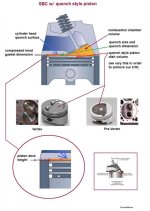Hello, I am planning a 350 chevy build for my 25' trophy command bridge.
This is my first marine build, so any suggestions would be greatly appreciated.
I have been reading up a bit and have made a few choices, but would like your expert opinions.
Using a new set of chevy vortex heads and a keith black D-dish piston I have the option of two different size dish pistons.
The +12cc pistons would yield 9.3 to 1 compression
The +18cc pistons would yield 8.7 to 1 compression
Assuming I will be running regular fuel which would be a better choice?
I am looking for a vortec low profile intake manifold - any suggestions ?
possible candidates:
Edelbrock Vortec EPS performer (even comes powder coated black)
professional products Cyclone (is it really 1/4" shorter? [or just marketing hype])
Can I run a edelbrock 500cfm street 4-barrel? What would be a good marine carb in this size range?
Thanks for your help, Roy
This is my first marine build, so any suggestions would be greatly appreciated.
I have been reading up a bit and have made a few choices, but would like your expert opinions.
Using a new set of chevy vortex heads and a keith black D-dish piston I have the option of two different size dish pistons.
The +12cc pistons would yield 9.3 to 1 compression
The +18cc pistons would yield 8.7 to 1 compression
Assuming I will be running regular fuel which would be a better choice?
I am looking for a vortec low profile intake manifold - any suggestions ?
possible candidates:
Edelbrock Vortec EPS performer (even comes powder coated black)
professional products Cyclone (is it really 1/4" shorter? [or just marketing hype])
Can I run a edelbrock 500cfm street 4-barrel? What would be a good marine carb in this size range?
Thanks for your help, Roy



